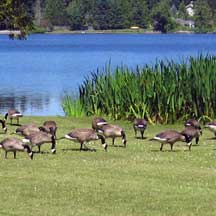Pathogens as a measure of ecological function
 What are pathogens?
What are pathogens?
Pathogens are bacteria and viruses that are destructive to humans and other animals, though they are a natural part of the environment that comes from fecal matter. In high concentration, pathogens can change how an ecosystem functions.
When and where are pathogens a concern?
Pathogens increase in areas with high concentrations of untreated fecal waste, both human and animal. For example, faulty septic systems, livestock manure and goose and pet waste from parks, beaches and expansive lawns can all increase pathogens in water bodies.
What affects pathogen levels?
Wetlands play a key role in filtering out pathogens and sediment in aquatic ecosystems. When wetlands are gone, so is a major way to remove pathogens from the ecosystem.
With an increase of impervious surfaces, and the accompanying decrease in the ability for pathogens (and water) to infiltrate the ground, pathogens move more quickly into aquatic systems and spend less time in environments that increase their mortality.
Channelization of roadside ditches and watercourses also contribute to the quick movement of pathogens from sources to aquatic areas.
References: Stanley et al 2005 (Acrobat pdf file)
Shoreline videos: Life on the Edge
Related information
- Environmental monitoring data
- Animals, plants and habitat
- Lake services and information
- King County watersheds

 Translate
Translate